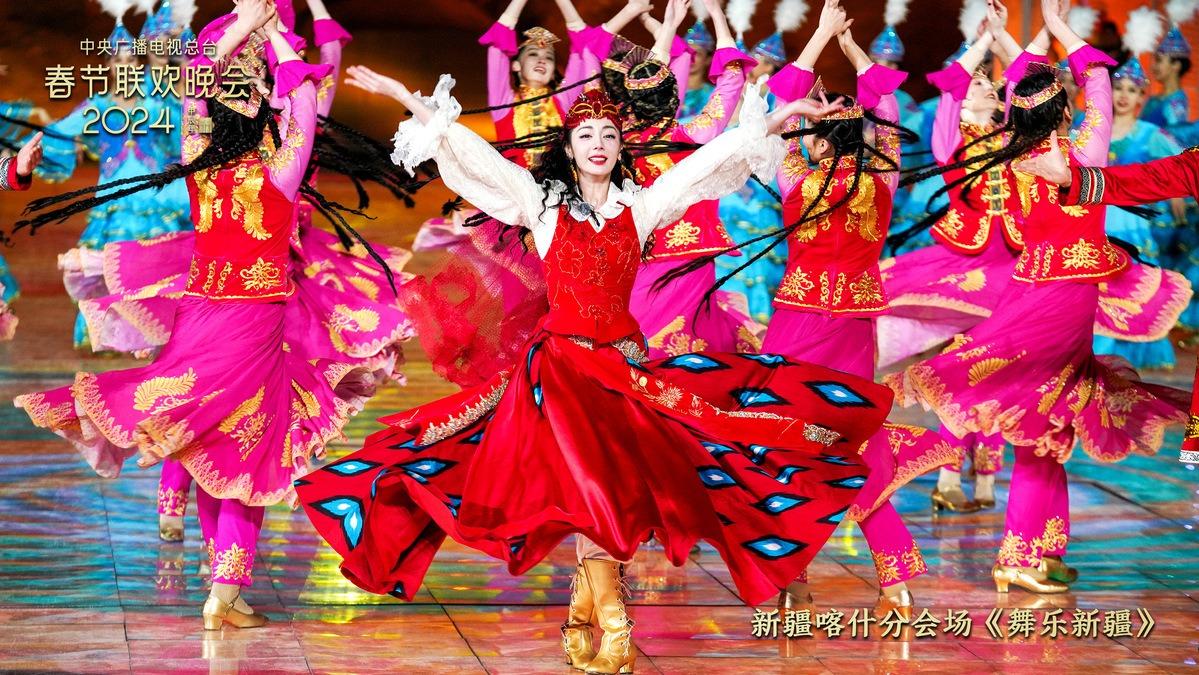 Dancers perform during the CCTV Spring Festival gala show on Feb 9, 2024. (PROVIDED TO CHINA DAILY)
Dancers perform during the CCTV Spring Festival gala show on Feb 9, 2024. (PROVIDED TO CHINA DAILY)
What is the world's most watched television show? Perhaps Chunwan, or the Spring Festival Gala produced by China Central Television. The Spring Festival Gala has a magical effect on the Chinese people, just like the Super Bowl has on Americans.
This year's gala, which lasted four hours, was filmed in Beijing; Shenyang, Liaoning province; Xi'an, Shaanxi province; Changsha, Hunan province, and Kashgar, in the Xinjiang Uygur autonomous region.
The country has been confidently demonstrating the superiority of socialism with Chinese characteristics when it comes to governance and economic development
In previous years, only Uygur music and dances were included in the gala. But this year, for the first time in 40 years, part of the Spring Festival Gala was filmed in the Xinjiang Uygur autonomous region. That Chunwan was filmed in Xinjiang is a historic event in itself.
READ MORE: Xinjiang steals the spotlight during New Year Gala
In fact, part of the gala was filmed in the heart of protected "Ancient Kashgar". The cultures of the Uygur, Kazakh, Kyrgyz and some other ethnic communities were showcased in the world's most watched program.
The impressive 8-minute show of the Uygurs was the most-talked-about episode of this year's Chunwan. In the more than 2,000-year-old city of Kashgar, which has houses and other structures made of clay and adobe bricks, innovative, state-of-the-art equipment was set up to film the program. Artists performed on eye-catching stages built on the roofs of 12 ordinary houses in Kashgar. Local artists from different ethnic groups sang and danced amid interplay of light and shadow.
The program in Kashgar brought together artists from different generations and ethnic backgrounds from across this culturally rich region. A group of prominent artists who grew up in Xinjiang including singer Wang Hongwei, actress Dilraba Dilmurat, and rapper Air also took part in the program.
Rapper Air said many musicians in Xinjiang are exploring the path of cross-cultural integration with Uygur music, while making continuous efforts to preserve and develop ethnic music. Actress Dilraba said she is proud of the progress and development of her hometown.
Dilraba has about 80 million followers on Weibo, China's answer to Twitter (now called X). No wonder the Uygur people were delighted to see Dilraba at the center of the 8-minute show filmed in Xinjiang. By integrating Kashgar's rich cultural heritage with modern elements, the gala showcased the new face of the ancient city in the new era.
The fact that the most striking element of China's most important TV program was Uygur culture made the United States and the "East Turkestan Islamic Movement" separatists very uncomfortable. As a result, they began claiming the Chinese government was "destroying" the region's culture, which is a blatant lie. In fact, the opposite is true: the Chinese government has helped preserve and develop ethnic minority groups' cultures, languages and practices.
Kashgar has been a cultural center since the times when the ancient Silk Road was flourishing. With its unique customs and traditions, Kashgar has become a national talking point in China. Kashgar, China's westernmost city, is about 4,000 km by road from Beijing. Despite this distance and sub-zero temperatures in winter, statistics show that in the just-concluded Spring Festival, from Feb 10 to 17, Kashgar received 988,500 tourists and achieved a tourism income of 807 million yuan ($112 million).
In the past decade the country's traditional cautious, defensive stance in international relations has changed. The country has been confidently demonstrating the superiority of socialism with Chinese characteristics when it comes to governance and economic development.
ALSO READ: Xinjiang lauded for its efforts on opening-up
Indeed, there is a need to publish detailed texts to defend the government's steps to eradicate the evils of terrorism, religious extremism and separatism from Xinjiang and safeguard the lives and livelihoods of the Uygur people. But there is also a need to more effectively explain the development the Uygur people have made and the role good governance has played in helping them make those achievements. This way of solving ethnic problems is unique to China.
As a matter of fact, the central government has shown the world how much importance it attaches to the Uygur people. And the fact that there has not been a single terrorist attack in Xinjiang in the past seven years shows the government's measures have been effective and have helped the Uygurs freely develop their culture and advance the regional economy.
I am writing these lines from Urumqi, and I can say China has succeeded in solving the ethnic problems in Xinjiang. China has shown that the best way to solve ethnic problems is to win the hearts and minds of ethnic minority groups and the shortest way to do so is to involve them in the governance of the country.
The author is chairman of the Turkish-Chinese Business Development and Friendship Association.
The views don't necessarily represent those of China Daily.


